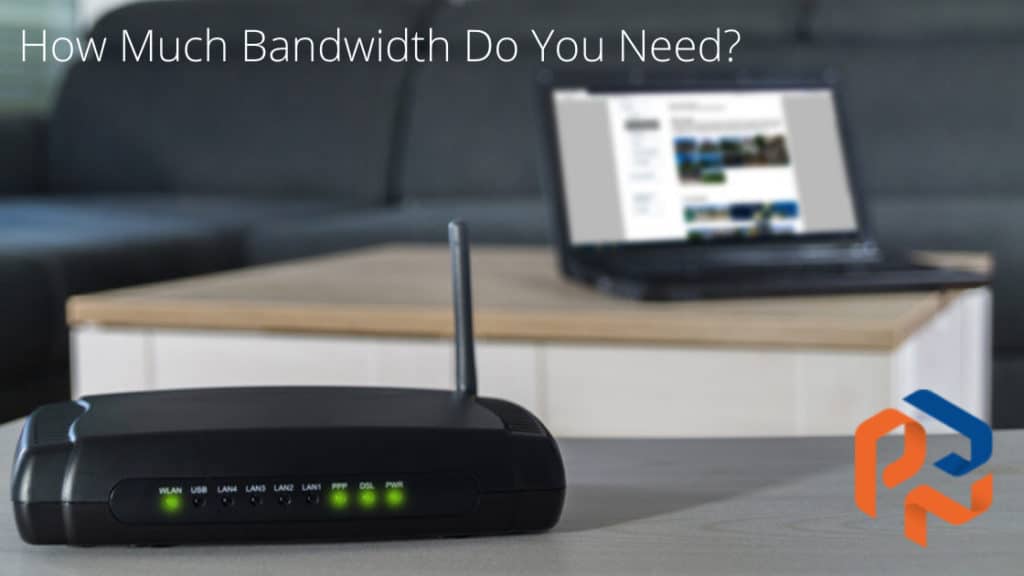How Much Bandwidth Do You Need?
The onset of COVID-19 has forced many businesses to change how they operate, requiring a remote working arrangement with their employees. Many employees are quickly discovering that they don’t have the bandwidth to effectively work from home due to inadequate or limited internet access. Understanding the broad scope of bandwidth standards can help you determine whether working from home is a long-term possibility for your staff or if you’ll need to make alternative arrangements — as there’s no end to social distancing insight.

What is Bandwidth?
Bandwidth is the amount of information that your Internet connection at home can handle every second. The more bandwidth you have available, the more data you can transfer at once. This data may include:
- Emails
- Videos
- Video conferencing
- Images and text from websites
- Voice-over-Internet-protocol (VoIP) phone calls
- Data you receive and send from cloud backup services
Internet connections typically have different bandwidth limits for downloads and uploads. Bandwidth is measured in megabytes per second (MBps) or bytes per second (Bps), which is the maximum amount of data that can be transferred through your Internet connection at home. Your download bandwidth is the amount of data you can receive each second, and the upload bandwidth is the amount of data you can send each second.
Not All Bandwidths Are Equal
Imagine two computers with the same internet speed at 100 MBps per second. If the first computer only has a 50 Mbps bandwidth, and the second one has 100 Mbps, the first computer would be able to download a 500 Megabit (Mb) file in ten seconds while the second computer would only take five seconds. This is because the first computer’s bandwidth is capped at 50 Mbps. Regardless of your internet speed, it’s the bandwidth that matters. The higher the bandwidth, the more data can be sent over a connection, contributing to faster uploads and downloads, and overall better internet experience.
How Much Bandwidth Do You Need To Work From Home?
The answer to this question is: it depends. If your job mainly consists of writing emails, editing, and using Google Docs, you can efficiently work remotely with limited bandwidth. However, if you need video conferencing capability, you need higher bandwidth. Making video calls with a lower bandwidth causes problems with pixelation. While you don’t need to conduct virtual meetings in 4K quality, you also don’t want your clients and colleagues to get cut off mid-conversation with patchy and choppy video streaming. If you are unsure what your requirements are, you can install a bandwidth monitor on your computer.
Video Conferencing Bandwidth Requirements
For One-On-One Calling
The following bandwidth is recommended for one-on-one calling:
- 600 Kbps (up/down) for high-quality video
- 1.2 Mbps (up/down) for 720p HD video
- Receiving 1080p HD video requires 1.8 Mbps (up/down)
- Sending 1080p HD video requires 1.8 Mbps (up/down)
For Group Video Calling
The following bandwidth is recommended for group video calling:
- 800 Kbps/1.0 Mbps (up/down) for high-quality video
- For 720p HD video: 1.5 Mbps (up/down)
- Receiving 1080p HD video requires 2.5 Mbps (up/down)
- Sending 1080p HD video requires 3.0 Mbps (up/down)
If you’re worried about your internet bandwidth, you can opt for audio calls instead of video calls, as this helps lower the information you need to upload and download.
Keeping your business safe and free from cyberattacks during COVID-19 is a priority for many companies, especially with more employees working remotely from home. It may be an excellent time to conduct a cybersecurity audit for your business. PNJ Technology Partners offers a complimentary initial consultation keeping local companies safe from attack during this difficult time. Contact us for this free initial assessment. For more tips and solutions on bandwidth and how you can work from home without a hitch, call us at 518-459-6712 or email info@pnjtechpartners.com for more information or receive quick support.

